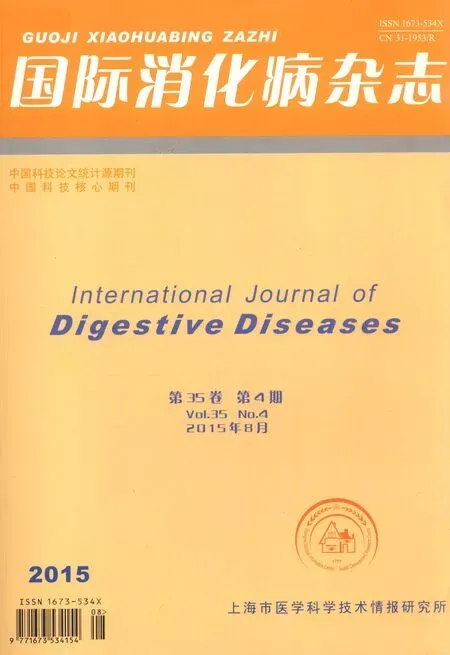活性氧簇与炎症性肠病
2015-03-20夏婷婷蒋晓芸
夏婷婷 钟 良 戎 兰 蒋晓芸
正常情况下机体内活性氧簇(ROS)的产生与抗氧化保护机制处于平衡状态,当受到紫外线照射、吸烟、饮酒、服用非类固醇类抗炎药(NSAID)、感染、缺血再灌注损伤和多种炎性反应时,ROS水平升高[1]。细胞内ROS的产生有多种方式,因组织不同而异,其中最主要的是一种还原型辅酶Ⅱ(NADPH)氧化酶(NOX)复合体,该复合体为跨膜蛋白,广泛存在于细胞膜、线粒体、过氧化物酶体和内质网中[2-3];此外,在线粒体内膜的电子传递链中也有部分ROS产生,尽管大部分氧被线粒体内细胞色素氧化酶完全还原为水,仍有少量氧不完全还原而生成ROS[4]。胃肠道是ROS的一个关键来源,尽管肠道上皮具有一层起保护作用的屏障,但是摄入的某些物质和病原体均可刺激肠上皮细胞、多形核中性粒细胞(PMN)、巨噬细胞等分泌炎性因子和其他炎性介质而发生炎性反应,这些炎性因子和炎性介质可促进氧化应激的发生[1]。
炎症性肠病(IBD)包括克罗恩病(CD)和溃疡性结肠炎(UC),是一种反复发作的慢性非特异性肠道炎性疾病,目前其病因和发病机制尚不明确,可能与肠道菌群失调、肠黏膜组织内免疫调节紊乱、肠黏膜屏障受损、环境和易感基因等有关。近年来,肠黏膜组织对共生菌的异常免疫反应成为IBD肠道炎性损伤机制的研究热点,而在免疫和炎性反应通路中ROS发挥了重要的作用[5]。ROS产生和代谢的动态平衡对于维持细胞和组织的正常功能是非常重要的,任何对这一平衡的破坏都可能导致氧化应激并产生一系列的组织细胞损伤。随着ROS在免疫调节中作用机制的研究进展,越来越多的证据表明ROS诱导的氧化应激是IBD发生发展中的一个重要因素。
1 ROS参与IBD肠道炎性损伤的证据
IBD作为一种反复发作的慢性疾病,其机制一直是临床研究的热点,通过建立多种动物模型模拟IBD的发病过程,可获得许多无法从人体得到的生物学信息,对于了解人类IBD发生发展的分子及细胞病理生理学机制具有指导意义。目前常用的实验动物模型包括化学诱导性[如硫酸葡聚糖(DSS)、三硝基苯磺酸(TNBS)]结肠炎小鼠和自发肠道炎性反应的基因工程鼠[白细胞介素-10(IL-10)敲除小鼠][6-7]。研究发现,在IBD动物模型的结肠黏膜中,ROS的产生增加,且表达水平与疾病的严重程度具有相关性[8-10];这一发现在IBD患者结肠黏膜内也得到证实,同时升高的还有某些氧化应激的生物标志物,如活性醛、F2-异前列腺素等脂质过氧化产物以及某些蛋白修饰产物(蛋白羰基)等[11-12]。相反,在小鼠模型结肠黏膜内的抗氧化剂谷胱甘肽和超氧化物歧化酶(SOD)的表达水平则下降[13];IBD患者血清及肠黏膜组织内的抗氧化剂维生素C、维生素E以及谷胱甘肽、SOD等亦有此表现[14]。
除了直接观察实验动物和患者体内ROS及抗氧化剂的水平外,曾有研究发现直接应用具有氧化活性的过氧化亚硝酸盐给健康小鼠灌肠可诱导小鼠结肠炎性反应[15],进一步说明ROS与肠道炎性损伤有着密切联系。而对IBD模型小鼠应用外源性抗氧化剂SOD后,发现肠道炎性反应有所缓解[16-17],说明抗氧化剂对结肠黏膜具有保护作用。近两年,有学者发现丹参乙酸镁能缓解DSS诱导的小鼠肠道炎性反应[18-19],而该药作为有效的抗氧化剂已在缺血缺氧性心血管疾病中得到普遍应用。外源性抗氧化剂对小鼠肠道的保护作用引起了国内外的广泛关注,虽然外源性抗氧化剂对人体的有效性尚待确定,但初步研究表明静脉注射磷脂SOD可降低活动性UC患者的疾病活动指数,用于缓解UC患者病情是安全有效的[20]。随着转基因技术的发展,通过控制内生性抗氧化酶的表达来研究ROS与IBD的关系,比如人Cu/Zn-SOD基因的过表达和离体细胞外SOD同工酶基因转入均可缓解DSS诱导的小鼠结肠炎[21-22],或用特异性抑制剂抑制内生性抗氧化酶的合成[23],或靶向破坏小鼠Gpx1、Gpx2基因,可引起小鼠结肠炎性反应的发生发展[24]。以上技术的应用,为ROS参与IBD的发生发展提供了更为有力的证据。
2 ROS参与IBD的可能机制
虽然许多证据表明ROS在肠道炎性反应中发挥重要作用,但具体的分子机制尚未完全阐明。肠道上皮作为机体与肠腔环境的界面,更容易受到来自外界病原体或有害物质的损伤,正常情况下ROS作为一种“杀伤性武器”参与肠道上皮的自我防御,比如在固有免疫中首先发现ROS参与了吞噬细胞的呼吸爆发从而杀伤吞入的病原体[25],后又发现其与白细胞的迁移也有关[26]。而在病理状态下,ROS产生与代谢的动态平衡、氧化与抗氧化系统的稳态均遭到破坏,致使氧化应激损伤形成,有学者认为ROS可能通过直接损伤和加重炎性反应发挥作用[27]。已知体内ROS的产生有多种方式,线粒体、内质网、过氧化物酶体、细胞核、细胞质、甚至细胞外空隙都可以产生ROS[28-29],其中线粒体电子传递链是大多数哺乳动物细胞内ROS的主要产生源[30],细胞质内还有可催化ROS产生的酶,如过氧化物酶、NOX、黄嘌呤氧化酶(XO)、脂氧合酶(LOX)、葡萄糖氧化酶、髓过氧化物酶(MPO)、一氧化氮合成酶和环氧合酶(COX)等[31-32]。但是结肠组织中的ROS主要来自于上皮细胞和吞噬性细胞的线粒体和NOX,其中结肠上皮细胞高表达NOX1[33],而 NOX2 则 主 要 表 达 于 吞 噬 性 细胞内[34]。
2.1 线粒体
在绝大多数真核细胞中,线粒体通过三羧酸循环和氧化磷酸化产生三磷酸腺苷(ATP)而提供能量,同时产生ROS,在正常线粒体呼吸链中,ROS的表达量处于低水平状态。近年来研究发现,ROS发挥作用时具有时空限制,一些亚细胞区室具有氧化性(如溶酶体和过氧化物酶体),而另一些具有还原性(如线粒体和细胞核),尽管线粒体具有还原性但仍易受到氧化损伤,可能与其区室内大量裸露的硫醇集团有关[35]。有研究认为肠上皮细胞中线粒体功能受损会导致上皮屏障作用减弱,扰乱上皮细胞与肠道菌群间的正常关系,从而导致IBD的发生和反复发作[36];用线粒体靶向的抗氧化剂(MTA)处理模型小鼠时,亦可发现结肠黏膜通透性降低[37],猜测可能与线粒体损伤后释放ROS,造成细胞蛋白质脂质过氧化及上皮细胞程序性死亡有关。
此外,还有研究发现线粒体ROS可直接刺激促炎细胞因子的产生[38],或者通过激活炎性小体NLRP3引起炎性级联放大效应[39]。线粒体ROS与NLRP3的关系是目前研究的热点,其可能通过氧化线粒体 DNA[40]、介导线粒体自噬[41]、破坏溶酶体膜稳定性[42]等机制参与NLRP3的激活,在这些机制中均存在Ca2+内流,故有学者认为介导Ca2+内流的非选择性阳离子通道TRPM2是将氧化应激和NLRP3联系起来的关键环节[43]。TRPM2是氧化应激敏感的多功能离子通道,广泛存在于各种细胞类型中,在细胞质膜和细胞器膜上均有分布,除可能参与NLRP3的激活外,据报道在人U937单核细胞中,H2O2诱导的CXCL8也依赖于TRPM2介导的Ca2+内流和后续的信号通路[44],NLRP3活化后可进一步激活caspase-1,介导IL-1β和IL-18的产生。以上促炎因子和黏附分子可招募和活化各种炎性细胞向氧化应激损伤处汇集,产生异常的免疫炎性反应,进一步加重肠道黏膜损伤。
2.2 NOX
正常情况下NOX源性ROS的产生在时间和空间上被严格控制着,NOX是一种跨膜的黄素细胞色素蛋白复合体,胞内段可将NADPH的一个电子转移到辅因子FAD上,然后再传递给血红簇,血红簇可将这一个电子贡献给膜外的O2形成O2-,调控这一过程的关键是载脂蛋白与黄素辅因子的装配[45],多种生长因子、化学趋化因子、肿瘤坏死因子(TNF)、C5a和LTB4等配体与受体的反应均可激活 NOX[46]。已知结肠上皮细胞内高表达NOX1[47],且多项研究表明细菌产物和促炎因子如IL-18、干扰素-γ(IFN-γ)和 TNF-α可刺激体外培养的肠上皮细胞NADPH氧化酶的表达和ROS的增加[48-49]。IBD 时,上皮细胞内 TNF-α浓度升高,NOX1的表达水平升高,ROS产生增加,应用NOX1抑制剂后则可降低TNF-α等促炎因子的水平[50]。NOX1在离体培养的人肠上皮细胞系(Caco-2细胞)中也高表达,用IL-1β处理该系细胞,可活化细胞内NOX1,使ROS产生增加,进而激活细胞内信号通路导致核因子-κB(NF-κB)活化、炎性酶系过表达和促炎介质释放,抑制NOX1活性后可在肠道水平调节炎性反应进程,阻止IL-1β诱导的上皮通透性增加[51]。
NOX2主要表达于吞噬性细胞表面,如巨噬细胞、单核细胞、中性粒细胞等,NOX2的活化是这些细胞吞噬作用下游事件中的关键,在杀伤吞噬体内病原体的过程中发挥主要作用[52-53],NOX2在吞噬体表面装配后,通过转移细胞质NADPH的电子至吞噬体内产生具有杀伤效应的ROS,吞噬体内NOX2源性ROS可通过直接杀伤微生物、调节pH和K+离子水平、激活信号转导级联反应、改变基因表达等多种途径产生效应[54]。此外,NOX2源性ROS还参与了中性粒细胞的迁移和促炎因子IL-1β的释放[26,55]。
3 小结
综上所述,线粒体长时间暴露于氧化呼吸链可生成ROS,且由于区室内含大量裸露的硫醇集团、缺乏保护机制等原因更易于受到氧化应激损伤,肠道上皮细胞同时还要应对来自外界的各种氧化应激,线粒体负荷相较于其他组织更重,上皮内线粒体损伤后,参与各种生理活动的ATP产生受到影响,导致上皮屏障功能紊乱,肠道共生菌及其产物侵入增多,上皮基质内吞噬细胞负荷增加,吞噬体及细胞内ROS过量产生致代谢失衡,造成吞噬细胞及上皮细胞直接损伤的同时,释放大量促炎介质和趋化因子,从而引起肠道内异常的免疫炎性反应。因此,IBD肠道损伤的形成与ROS的产生密切相关。
1 Bhattacharyya A,Chattopadhyay R,Mitra S,et al.Oxidative stress:an essential factor in the pathogenesis of gastrointestinal mucosal diseases.Physiol Rev,2014,94:329-354.
2 Muller F.The nature and mechanism of superoxide production by the electron transport chain:Its relevance to aging.J Am Aging Assoc,2000,23:227-253.
3 Han D,Williams E,Cadenas E.Mitochondrial respiratory chain-dependent generation of superoxide anion and its release into the intermembrane space.Biochem J,2001,353:411-416.
4 Boveris A,Chance B.The mitochondrial generation of hydrogen peroxide.General properties and effect of hyperbaric oxygen.Biochem J,1973,134:707-716.
5 Yang Y,Bazhin AV,Werner J,et al.Reactive oxygen species in the immune system.Int Rev Immunol,2013,32:249-270.
6 Mizoguchi A,Mizoguchi E.Animal models of IBD:linkage to human disease.Curr Opin Pharmacol,2010,10:578-587.
7 Byrne FR,Viney JL.Mouse models of inflammatory bowel disease.Curr Opin Drug Discov Devel,2006,9:207-217.
8 Tanida S,Mizoshita T,Mizushima T,et al.Involvement of oxidative stress and mucosal addressin cell adhesion molecule-1(MAdCAM-1)in inflammatory bowel disease.J Clin Biochem Nutr,2011,48:112-116.
9 Pravda J.Radical induction theory of ulcerative colitis.World J Gastroenterol,2005,11:2371-2384.
10 Pavlick KP,Laroux FS,Fuseler J,et al.Role of reactive metabolites of oxygen and nitrogen in inflammatory bowel disease.Free Radic Biol Med,2002,33:311-322.
11 Hatsugai M,Kurokawa MS,Kouro T,et al.Protein profiles of peripheral blood mononuclear cells are useful for differential diagnosis of ulcerative colitis and Crohn′s disease. J Gastroenterol,2010,45:488-500.
12 Cracowski JL,Bonaz B,Bessard G,et al.Increased urinary F2-isoprostanes in patients with Crohn′s disease. Am J Gastroenterol,2002,97:99-103.
13 Isman CA, Yegen BC, Alican I. Methimazole-induced hypothyroidism in rats ameliorates oxidative injury in experimental colitis.J Endocrinol,2003,177:471-476.
14 Alzoghaibi MA.Concepts of oxidative stress and antioxidant defense in Crohn′s disease.World J Gastroenterol,2013,19:6540.
15 Rachmilewitz D,Stamler JS,Karmeli F,et al.Peroxynitriteinduced rat colitis--a new model of colonic inflammation.Gastroenterology,1993,105:1681-1688.
16 Ishihara T,Tanaka K,Tasaka Y,et al.Therapeutic effect of lecithinized superoxide dismutase against colitis.J Pharmacol Exp Ther,2009,328:152-164.
17 Segui J,Gironella M,Sans M,et al.Superoxide dismutase ameliorates TNBS-induced colitis by reducing oxidative stress,adhesion molecule expression,and leukocyte recruitment into the inflamed intestine.J Leukoc Biol,2004,76:537-544.
18 Jiang X,Jiang Y,Sun D,et al.Protective effect of magnesium lithospermate B against dextran sodiumsulfate induced ulcerative colitis in mice.Environ Toxicol Pharmacol,2013,36:97-102.19 Qu J,Ren X,Hou RY,et al.The protective effect of magnesium lithospermate B against glucose-induced intracellular oxidative damage.Biochem Biophys Res Commun,2011,411:32-39.
20 Suzuki Y,Matsumoto T,Okamoto S,et al.A lecithinized superoxide dismutase (PC-SOD)improves ulcerative colitis.Colorectal Dis,2008,10:931-934.
21 Oku T,Iyama S,Sato T,et al.Amelioration of murine dextran sulfate sodium-induced colitis by ex vivo extracellular superoxide dismutase gene transfer.Inflamm Bowel Dis,2006,12:630-640.
22 Kruidenier L,van Meeteren ME,Kuiper I,et al.Attenuated mild colonic inflammation and improved survival from severe DSS-colitis of transgenic Cu/Zn-SOD mice.Free Radic Biol Med,2003,34:753-765.
23 Martensson J,Jain A,Meister A.Glutathione is required for intestinal function.Proc Natl Acad Sci U S A,1990,87:1715-1719.
24 Esworthy RS,Aranda R,Martin MG,et al.Mice with combined disruption of Gpx1 and Gpx2 genes have colitis.Am J Physiol Gastrointest Liver Physiol,2001,281:G848-G855.
25 Babior BM.The respiratory burst of phagocytes.J Clin Invest,1984,73:599-601.
26 Yoo SK,Starnes TW,Deng Q,et al.Lyn is a redox sensor that mediates leukocyte wound attraction in vivo.Nature,2011,480:109-112.
27 Zhu H,Li YR.Oxidative stress and redox signaling mechanisms of inflammatory bowel disease:updated experimental and clinical evidence.Exp Biol Med,2012,237:474-480.
28 Balaban RS,Nemoto S,Finkel T.Mitochondria,oxidants,and aging.Cell,2005,120:483-495.
29 Pritchard KJ,Ackerman AW,Gross ER,et al.Heat shock protein 90 mediates the balance of nitric oxide and superoxide anion from endothelial nitric-oxide synthase.J Biol Chem,2001,276:17621-17624.
30 Poyton RO,Castello PR,Ball KA,et al.Mitochondria and hypoxic signaling:a new view.Ann N Y Acad Sci,2009,1177:48-56.
31 Kulkarni AC,Kuppusamy P,Parinandi N.Oxygen,the lead actor in the pathophysiologic drama:enactment of the trinity of normoxia,hypoxia,and hyperoxia in disease and therapy.Antioxid Redox Signal,2007,9:1717-1730.
32 Swindle EJ,Metcalfe DD.The role of reactive oxygen species and nitric oxide in mast cell-dependent inflammatory processes.Immunol Rev,2007,217:186-205.
33 Szanto I,Rubbia-Brandt L,Kiss P,et al.Expression of NOX1,a superoxide-generating NADPH oxidase,in colon cancer and inflammatory bowel disease.J Pathol,2005,207:164-176.
34 Sumimoto H,Miyano K,Takeya R.Molecular composition and regulation of the Nox family NAD(P)H oxidases.Biochem Biophys Res Commun,2005,338:677-686.
35 Kaludercic N,Deshwal S,Di Lisa F.Reactive oxygen species and redox compartmentalization.Front Physiol,2014,5:285.36 Schoultz I,Soderholm JD,McKay DM.Is metabolic stress a common denominator in inflammatory bowel disease?Inflamm Bowel Dis,2011,17:2008-2018.
37 Wang A,Keita AV,Phan V,et al.Targeting mitochondriaderived reactive oxygen species to reduce epithelial barrier dysfunction and colitis.Am J Pathol,2014,184:2516-2527.
38 Li X,Fang P,Mai J,et al.Targeting mitochondrial reactive oxygen species as novel therapy for inflammatory diseases and cancers.J Hematol Oncol,2013,6:19.
39 Lawlor KE,Vince JE.Ambiguities in NLRP3 inflammasome regulation:is there a role for mitochondria?Biochim Biophys Acta,2014,1840:1433-1440.
40 Shimada K,Crother TR,Karlin J,et al.Oxidized mitochondrial DNA activates the NLRP3 inflammasome during apoptosis.Immunity,2012,36:401-414.
41 Lupfer C,Thomas PG,Anand PK,et al.Receptor interacting protein kinase 2-mediated mitophagy regulates inflammasome activation during virus infection.Nat Immunol,2013,14:480-488.
42 Heid ME,Keyel PA,Kamga C,et al.Mitochondrial reactive oxygen species induces NLRP3-dependent lysosomal damage and inflammasome activation.J Immunol,2013,191:5230-5238.
43 Zhong Z,Zhai Y,Liang S,et al.TRPM2links oxidative stress to NLRP3 inflammasome activation.Nat Commun,2013,4:1611.
44 茹筱晨,姚晓强.TRPM2:氧化应激敏感的多功能离子通道.生理学报,2014,66:7-15.
45 Yazdanpanah B,Wiegmann K,Tchikov V,et al.Riboflavin kinase couples TNF receptor 1 to NADPH oxidase.Nature,2009,460:1159-1163.
46 Nathan C,Cunningham-Bussel A.Beyond oxidative stress:an immunologist's guide to reactive oxygen species.Nature Reviews Immunology,2013,13:349-361.
47 Bokoch GM,Knaus UG.NADPH oxidases:not just for leukocytes anymore!Trends Biochem Sci,2003,28:502-508.
48 O'Leary DP,Bhatt L,Woolley JF,et al.TLR-4 signalling accelerates colon cancer cell adhesion via NF-kappaB mediated transcriptional up-regulation of Nox-1.PLoS One,2012,7:e44176.
49 Rokutan K,Kawahara T,Kuwano Y,et al.Nox enzymes and oxidative stress in the immunopathology of the gastrointestinal tract.Semin Immunopathol,2008,30:315-327.
50 Ramonaite R,Skieceviciene J,Juzenas S,et al.Protective action of NADPH oxidase inhibitors and role of NADPH oxidase in pathogenesis of colon inflammation in mice.World J Gastroenterol,2014,20:12533-12541.
51 Tesoriere L,Attanzio A,Allegra M,et al.Indicaxanthin inhibits NADPH oxidase (NOX)-1 activation and NF-κB-dependent release of inflammatory mediators and prevents the increase of epithelial permeability in IL-1β-exposed Caco-2 cells.Br J Nutr,2014,111:415-423.
52 Rada B,Hably C,Meczner A,et al.Role of Nox2 in elimination of microorganisms.Semin Immunopathol,2008,30:237-253.
53 Nauseef WM.How human neutrophils kill and degrade microbes:an integrated view.Immunol Rev,2007,219:88-102.
54 Huang J,Canadien V,Lam GY,et al. Activation of antibacterial autophagy by NADPH oxidases.Proc Natl Acad Sci U S A,2009,106:6226-6231.
55 Gabelloni ML,Sabbione F,Jancic C,et al.NADPH oxidase derived reactive oxygen species are involved in human neutrophil IL-1βsecretion but not in inflammasome activation.Eur J Immunol,2013,43:3324-3335.
